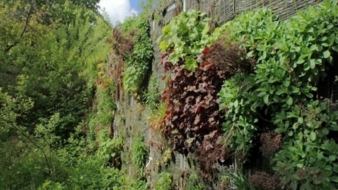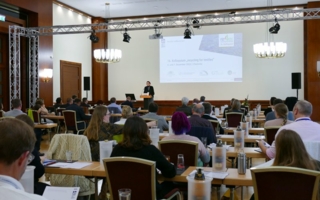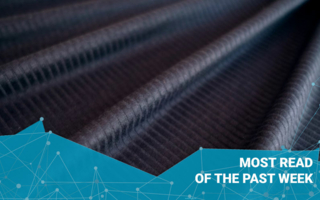17/06/2022 – Techtextil: STFI — auf Deutsch lesen
Sustainable, mobile and digital
The Saxon Textile Research Institute (STFI) will be presenting innovative highlights from research and develop-ment at Techtextil 2022.
In addition to a warp-knitted textile façade greening in a modular system and textile lightweight construction elements for the building sector made from hemp as a renewable raw material, the STFI will also be showing innovations from nonwovens research. The project optiformTEX is an example of the nonwovens competence: in this project, the mass per unit area was specifically influenced for the production of semi-finished products in the automotive sector. Furthermore, the Chemnitz Institute exhibits an ecological foam coating for protective textiles. Central highlight of the STFI’s presence at the fair is also a mobile robot system, which demonstrates the automated loading of a small-scale bobbin creel.
Highlights:
- The greened façade tile is a modern, visually appealing system with which large building surfaces can be cost-effectively greened through a simple, modular segment structure. In addition to insulating the building, the system has been created to meet the design requirements of a modern city centre; low maintenance greening is made possible through functional integration in the textile carrier layer and coordinated plant selection.
- Moulded components made of natural fibre nonwovens are increasingly used in the automotive sector. Conventional nonwovens currently have uniform masses per unit area. Technical solutions for load-oriented component reinforcement and the resulting optimised use of materials represent an enormous economic potential. The basic idea of “optiformTEX” was therefore to specifically influence the mass per unit area distribution in the pile before the semi-finished product is consolidated. As a result, a textile-technological process and the corresponding plant component were successfully developed.
- Future-oriented materials are offered by developments from the field of renewable raw materials in combination with bio-based resin systems: In the “Gro-Coce” project, an innovative ceiling system was developed by combining sustainable building products and methods. Currently, a high-performance hemp-based semi-finished product as well as the steps for its reproducible production by means of textile surface formation is developed by the research team. Initial application and load tests of the hemp-based semi-finished products on wooden beams confirmed the high performance potential of the natural fibre materials.
- Special functional textiles are based on composite materials with coatings or membranes. The previous production of the coatings/membranes poses ecological and health risks. At STFI, solvent-free, purely aqueous coating systems and a technology for their application were therefore developed for the protective textile sector, resulting in a breathable, waterproof and wash-resistant textile coating.
- The central highlight of the STFI's presence at the fair is a mobile robot system, which demonstrates the automated loading of a small-scale bobbin creel. At the STFI, the robot is part of the “textile factory of the future”, where a play mat is woven and processed step by step along the textile chain
Techtextil: Hall 11.1, Booth D34




